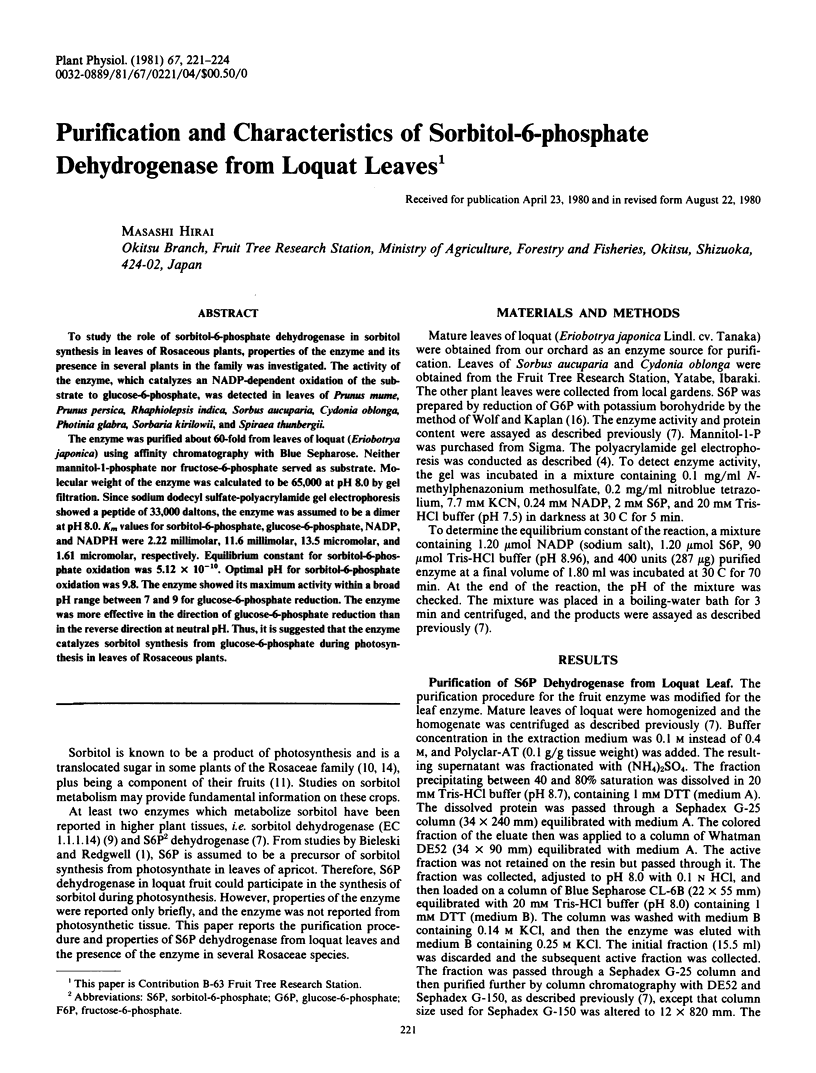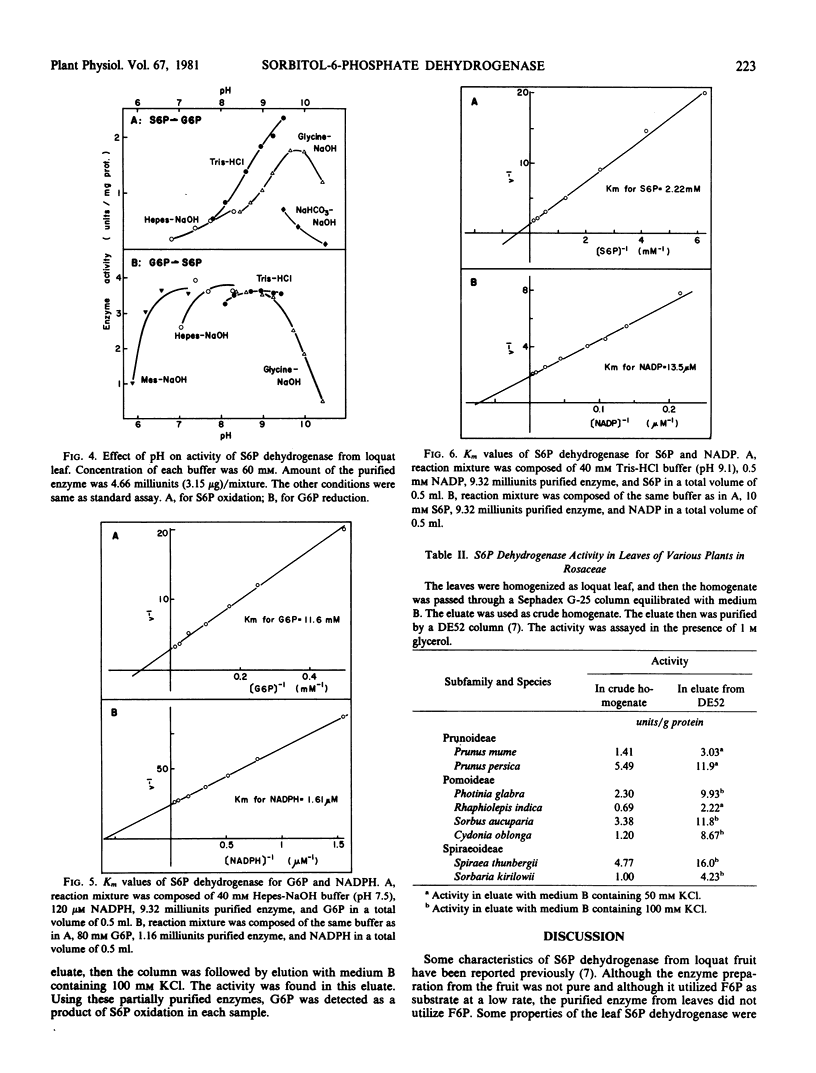Abstract
To study the role of sorbitol-6-phosphate dehydrogenase in sorbitol synthesis in leaves of Rosaceous plants, properties of the enzyme and its presence in several plants in the family was investigated. The activity of the enzyme, which catalyzes an NADP-dependent oxidation of the substrate to glucose-6-phosphate, was detected in leaves of Prunus mume, Prunus persica, Rhaphiolepsis indica, Sorbus aucuparia, Cydonia oblonga, Photinia glabra, Sorbaria kirilowii, and Spiraea thunbergii.
The enzyme was purified about 60-fold from leaves of loquat (Eriobotrya japonica) using affinity chromatography with Blue Sepharose. Neither mannitol-1-phosphate nor fructose-6-phosphate served as substrate. Molecular weight of the enzyme was calculated to be 65,000 at pH 8.0 by gel filtration. Since sodium dodecyl sulfate-polyacrylamide gel electrophoresis showed a peptide of 33,000 daltons, the enzyme was assumed to be a dimer at pH 8.0 Km values for sorbitol-6-phosphate, glucose-6-phosphate, NADP, and NADPH were 2.22 millimolar, 11.6 millimolar, 13.5 micromolar, and 1.61 micromolar, respectively. Equilibrium constant for sorbitol-6-phosphate oxidation was 5.12 × 10−10. Optimal pH for sorbitol-6-phosphate oxidation was 9.8. The enzyme showed its maximum activity within a broad pH range between 7 and 9 for glucose-6-phosphate reduction. The enzyme was more effective in the direction of glucose-6-phosphate reduction than in the reverse direction at neutral pH. Thus, it is suggested that the enzyme catalyzes sorbitol synthesis from glucose-6-phosphate during photosynthesis in leaves of Rosaceous plants.
Full text
PDF



Images in this article
Selected References
These references are in PubMed. This may not be the complete list of references from this article.
- DAVIS B. J. DISC ELECTROPHORESIS. II. METHOD AND APPLICATION TO HUMAN SERUM PROTEINS. Ann N Y Acad Sci. 1964 Dec 28;121:404–427. doi: 10.1111/j.1749-6632.1964.tb14213.x. [DOI] [PubMed] [Google Scholar]
- FAULKNER P. Enzymic reduction of sugar phosphates in insect blood. Biochem J. 1956 Nov;64(3):436–441. doi: 10.1042/bj0640436. [DOI] [PMC free article] [PubMed] [Google Scholar]
- Hedrick J. L., Smith A. J. Size and charge isomer separation and estimation of molecular weights of proteins by disc gel electrophoresis. Arch Biochem Biophys. 1968 Jul;126(1):155–164. doi: 10.1016/0003-9861(68)90569-9. [DOI] [PubMed] [Google Scholar]
- Hirai M. Sorbitol-6-phosphate dehydrogenase from loquat fruit. Plant Physiol. 1979 Apr;63(4):715–717. doi: 10.1104/pp.63.4.715. [DOI] [PMC free article] [PubMed] [Google Scholar]
- LISS M., HORWITZ S. B., KAPLAN N. O. D-Mannitol 1-phosphate dehydrogenase and D-sorbitol 6-phosphate dehydrogenase in Aerobacter aerogenes. J Biol Chem. 1962 Apr;237:1342–1350. [PubMed] [Google Scholar]
- Negm F. B., Loescher W. H. Detection and characterization of sorbitol dehydrogenase from apple callus tissue. Plant Physiol. 1979 Jul;64(1):69–73. doi: 10.1104/pp.64.1.69. [DOI] [PMC free article] [PubMed] [Google Scholar]
- SHOCKLEY T. E., PRIDE H. S. D-sorbitol-6-phosphate dehydrogenase from Lactobacillus casei. J Bacteriol. 1959 Jun;77(6):695–700. doi: 10.1128/jb.77.6.695-700.1959. [DOI] [PMC free article] [PubMed] [Google Scholar]
- WILLIAMS-ASHMAN H. G., BANKS J. The ketose reductase of rat liver and accessory sexual organs. Arch Biochem Biophys. 1954 Jun;50(2):513–515. doi: 10.1016/0003-9861(54)90072-7. [DOI] [PubMed] [Google Scholar]
- WOLFF J. B., KAPLAN N. O. D-Mannitol 1-phosphate dehydrogenase from Escherichia coli. J Biol Chem. 1956 Feb;218(2):849–869. [PubMed] [Google Scholar]
- Weber K., Osborn M. The reliability of molecular weight determinations by dodecyl sulfate-polyacrylamide gel electrophoresis. J Biol Chem. 1969 Aug 25;244(16):4406–4412. [PubMed] [Google Scholar]



